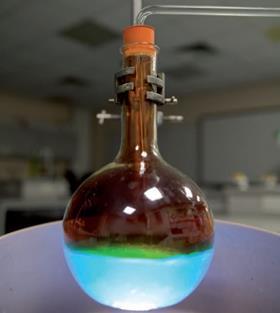Copper Reacting With Nitric Acid
The dramatic reaction betwixt copper and nitric acid ought to be seen by all mail service-16 students. It provides an excellent opportunity to explain observations using the electrochemical series and makes the point that there's more to consider about an acrid than its dissociated protons. As well as showing how dramatically copper reacts with nitric acid, this adapted sit-in besides uses the high solubility of nitrogen dioxide to initiate a pleasing fountain.

Kit
- 5 g copper turnings
- 40 cm3 concentrated nitric acrid
- 1 dm3 round-bottomed borosilicate flask. Preferably thick-walled.
- clench stand
- delivery tube
- ane dmiii conical flask
- drinking glass wool
- bowl or trough
- safety screens (if in open up lab)
Safety
- Concentrated nitric acid is corrosive and oxidising - wear goggles or face shield. The use of nitrile gloves is recommended. Wear gloves – CLEAPSS members should consult GL349.
- Nitrogen dioxide is toxic - the gas is bubbled through water in which it will dissolve and react. Improvidence of whatever remaining NOtwo tin exist controlled by a piece of glass wool (handle with forceps or gloves) in the neck of the flask.
- This demonstration can be performed either in the open lab or in a fume cupboard.
- Earlier the demonstration, check the flask for cracks or faults.
- The fountain reaction is initiated by 'suck back' post-obit the exothermic reaction which carries a small run a risk of damage to the flask. If performed in the open lab, separate rubber screens should be used to protect the audience and the demonstrator. If performed in a smoke cupboard, the sash can be pulled down to serve the aforementioned purpose. The basin is there to catch spillage.
Procedure
Grooming
Fill the conical flask with water and add the acid to the circular-bottomed flask. Clamp the circular-bottomed flask into position and check that the commitment tube, when in place, is at the lesser of the flask. Loosely plug the cervix of the conical flask with glass wool, leaving the delivery tube in position, ready to exist removed when the copper is added. Add a trough or basin under the round-bottomed flask to take hold of any acid that may leak if the glass fails.
In front end of the audience
Add the copper and fit the delivery tube. Lower the sash (if in a fume closet). The solution volition apace plow light-green and evolve red/brown nitrogen dioxide. After about eighty seconds the reaction will slow and the gases in the round-bottomed flask with cool. Equally h2o is drawn back into the vessel past the reduction in force per unit area, the nitrogen dioxide dissolves and reacts in it, initiating a dramatic fountain.
Culling methods
Due to its thick walls, a Buchner flask may provide an alternative vessel for the reaction if an advisable round-bottomed flask is unavailable.
Teaching goal
From their outset forays into reactivity, students perform experiments which bear witness them that copper doesn't react with acid. 1 point of teaching the reactivity series is as a stepladder to the electrochemical series, so it makes sense to specifically indicate out to students that it's a lilliputian flake more complicated than that.
This demonstration could be introduced past reminding students of the practicals they volition have washed lower down the school adding metallic strips to dilute hydrochloric acrid, either by demonstrating it or past giving students a list of reactions to predict the outcomes of (including both hydrochloric and nitric acids).
The reaction proceeds as:
Cu(s) + 4HNOiii (aq) → Cu(NO3)2 (aq) + 2NO2 (g) + 2H2O(l)
The initial light-green color is associated with the copper when ligated by nitrate ions in high concentration in the acid.* As water is added, information technology displaces the nitrate ions producing the feature bluish colour in the fountain.
Post-obit the demonstration, students can practice using the electrochemical series to predict the consequence of reactions by combining half cells (from a standard textbook) to explain how magnesium and copper react with hydrochloric and nitric acids in the way they practice.
This article's Rubber notes were updated July 2021.
Copper Reacting With Nitric Acid,
Source: https://edu.rsc.org/exhibition-chemistry/dissolving-copper-in-nitric-acid/2020047.article
Posted by: gentrysaughts1992.blogspot.com


0 Response to "Copper Reacting With Nitric Acid"
Post a Comment